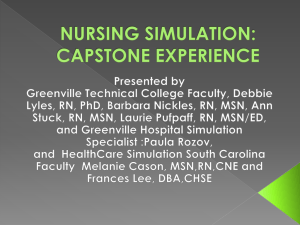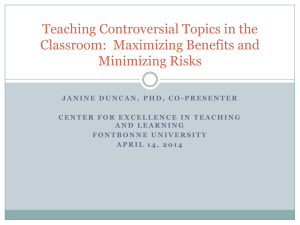Marketing: Reaching Underserved Populations
advertisement
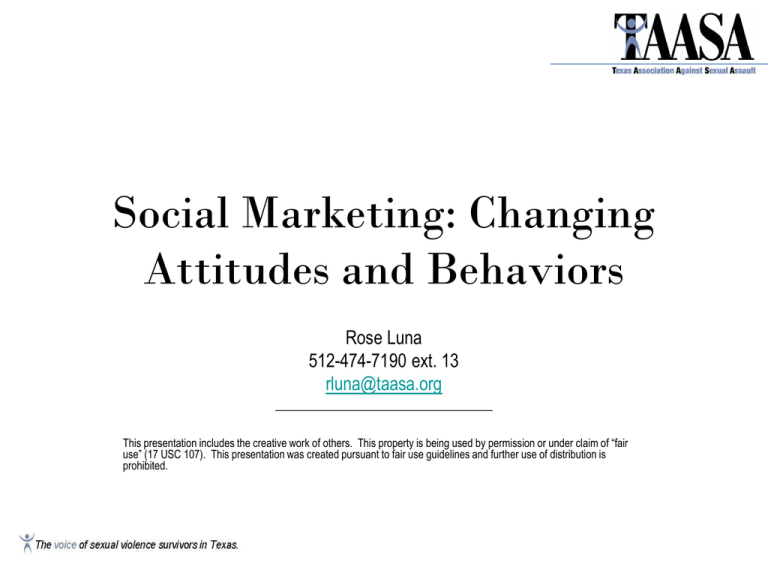
Social Marketing: Changing Attitudes and Behaviors Rose Luna 512-474-7190 ext. 13 rluna@taasa.org ________________________________ This presentation includes the creative work of others. This property is being used by permission or under claim of “fair use” (17 USC 107). This presentation was created pursuant to fair use guidelines and further use of distribution is prohibited. What is Social/Grassroots Marketing? “The application of commercial marketing techniques to social problems” Community Tool Box – ctb.ku.edu/tools What is Social Marketing? • • • • • • Challenging your community Challenging existing social, political and cultural systems Thorough, effective and far reaching Motivating people to take action Changing people’s behaviors A series of sustainable activities/interventions that engage communities to take action • LONG TERM!!!!!!!!! Changing Attitudes/Behaviors Risks Time •Take Notice •Consider •Choice •Take Action Effort Energy A Combined approach: Influencing Agendas Top Down (Policy Agenda) (Media Agenda) Bottom Up (Public Agenda) Top Down • • • • • • • Institutions Government – politicians, legislature Data Assemblers (both macro & micro) Think Tanks Media Gatekeepers Advocacy Groups (NAACP, NRA, AARP) Local control – city council, board of directors, commissioners, school boards & etc. Bottom Up • Those exhibiting the behavior you wish to change • The local community or society you wish to engage • Cultural systems and structures Child Obesity Bottom Up 1. Eating habits 2. Exercise Top Down 1. Eating habits – school lunches, cultural eating habits, home situation, 2. Exercise- small or concrete yards, lack of lighting, dangerous streets, lack of youth centers in area. Staples of Corporate Marketing • Research • Implementation • Reassess / Redirect Marketing Terms Marketing - is the process of planning and executing the conception, pricing, promotion and distribution of ideas, goods, and services to create and maintain relationships that will satisfy individual and organizational objectives Belch, George., Belch Michael. Advertising & Promotion. Boston: Irwin, McGraw-Hill, 1995. Marketing Reach – the number of individuals exposed to your message and the depth of message infiltration Market segmentation – the process of grouping segments of the community based on commonalities and/or similarities Target market (audience) – the particular segment of a total population to which the message/activity/intervention is aimed 4 P’s of Corporate Marketing • • • • Packaging (Place) Price Product Promotion Staples of Grassroots Marketing • Research • Implementation • Reassess / Redirect Elements of a Social Marketing Campaign • • • • • • Analyze Community Build Collaboration/Coalition Define an Issue/Behavior to change Chose a Course of Action Attention to the Problem Reassess or Redirect efforts Analysis of Your Community • Bottom up Community – Community at large both directly and indirectly affected • Top down community – Community in position to change rules, laws and etc. (those with power both formal and informal) Analysis of Your Community : Demographics • • • • • • • • • Geographic Socio-economic Socio-cultural Political Gender Family structure Age Community Groups (both formal and informal) …..to name a few Analysis of Groups / Build Collaborations • Identify all community groups both formal and informal • Political – Who runs the group/community • What groups exist – research successes/records of those groups • Existing community groups working relationship – find out why particular groups do or do not work together (Find a way to bridge gap) Build Collaboration • A collaboration is a group of individuals and/or organizations with a common interest who agree to work together toward a common goal. (s. fawcett et.al) • Approach/Invite Define an Issue • Identify an issue to solve/behavior to change • Evidence • Data – can help formulate a plan Chose a Course of Action • • • • • • • • Based on research!! Consider audience Influential factors Listen to community Scenario building Costs involved Identify barriers Reduce barriers Attention to the Problem • Activate the community • Identify the various market segments (target market or audience) • Focus on several different segments to reach – Different approach to each segment • Keep the issue on the forefront of public, media and policy agenda’s Reassess / Redirect The Parallels of Corporate-Social Marketing Corporate Marketing Research Social Marketing Research Social Marketing Campaign Research Analyze Community Build Collaboration Define an Issue Implementation 4 P's Product Price Packaging Promotion Reassess / Redirect Efforts Implementation 4 P's Action Steps, List of Solutions Possible Barriers, Price of Inaction Framing of Message, Perception Approach, Engagement of Community Reassess / Redirect Efforts Implementation 4 P's Choose Course of Action Choose Course of Action Attention to the Problem Attention to the Problem Reassess / Redirect Efforts Seat Belt and Child Restraint Initiative • Since Mobilizations began (1997): • Child fatalities have dropped by more than 20 percent. • Child restraint use for infants under one has risen from 85 percent to 99 percent • Restraint use among toddlers, ages 1-4, has jumped even more dramatically from 60 to 94 percent. • Adult seat belt use rose from 62 percent to 79 percent - the highest use rate ever - with more than 50 million Americans buckling up. • http://www.nsc.org/airbag.htm MADD • • • • • Designated Driver Alcohol related deaths per year have declined from 26,173 in 1982 to 16,885 in 2005 Thousands of anti-drunk driving laws have been passed Successfully advocated for strict and severe punishment of offenders of laws against drinking and driving. Heavily involved in lobbying to reduce the legal limit for blood alcohol from BAC.10 to BAC.08 http://en.wikipedia.org/wiki/Mothers_Against_Drunk_Driving Thank You!!!!!!!!!!!!!!! Rose Luna Training/Diversity Specialist 512-474-7190 ext. 13
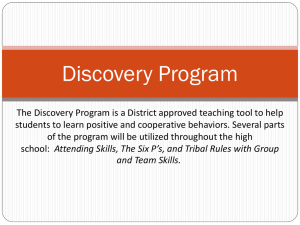

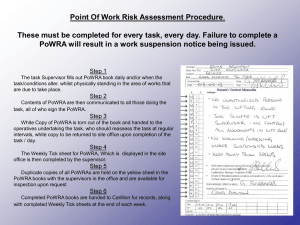
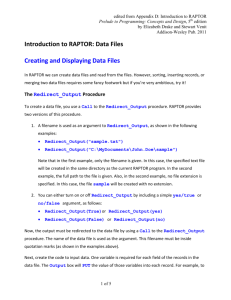
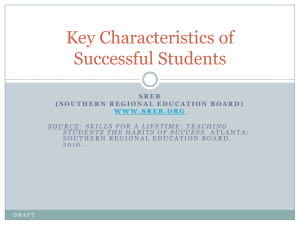
![[#OPENAM-1930] OAuth2 Authorization Code Grant – null or](http://s3.studylib.net/store/data/005845083_1-7a047cd5460e01e6ff673ccae0552bef-300x300.png)
